Indiana
| |
 |
Bloomington |
Indiana |
USA |
Horizontal Dial |
Dial 336 |
| A 24 inch octagonal horizontal dial probably made of marble. The dial is plain, with Roman numerals at the end of hour lines. The gnomon is a simple open triangle of well aged brass. The base is an octagonal pillar surrounded by flowers.
The dial was struck by a falling tree in spring 2011. The gnomon style is broken and bent and the support has several large cracks. The falling tree also damaged the surrounding fence. |
| |
| |
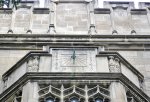 |
Bloomington |
Indiana |
USA |
Vertical Dial |
Dial 728 |
| An approximately 4 foot square, limestone south-facing vertical dial with a bronze gnomon. Dial face has hour lines and half-hour marks with Arabic numerals. Tall trees shade the dial most of the day. |
| |
| |
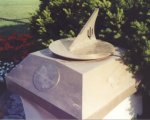 |
Bloomington |
Indiana |
USA |
Horizontal Dial |
Dial 38 |
| A small horizontal dial, about 18 inches in diameter. The dial plate is tilted 2 deg to the horizon to allow water run-off. However, more unusual is the base that contains a hand crank connected to a scalloped drum that tilts the entire dial to adjust for the Equation of Time. The drum is rotated to the current date and the drum edge pushes a cam that tilts the plane of the horizontal face so that standard time is indicated to within half a minute. The dial is actually mounted on an equatorial axis. Since 1979 the dial has gone into a state of disrepair and is overgrown by bushes. |
| |
| |
 |
Clarksville |
Indiana |
USA |
Horizontal Dial |
Dial 1112 |
| This is a round,George marble sundial 48-inches (122cm) in diameter with a plain triangular gnomon. The chapter ring has Roman hours etched from 5am to 7pm, delineated in quarter hours. The dial sits 8-inches (20cm) above a 60-inch (152cm) wide concrete base. Official town records show that this dial was donated to the town of Clarksville to commemorate the country's Bicentennial in 1976. The inscription says the dial was dedicated to George Rogers Clark, the town’s founder and a Revolutionary War hero. He was the brother of William Clark of “Lewis & Clark Expedition” fame. |
| |
| |
 |
Columbus |
Indiana |
USA |
Horizontal Dial |
Dial 674 |
| A 10 foot diameter horizontal dial of concrete, stainless steel and brick. The gnomon is a massive concrete structure and the Arabic hour markers are inset in the concrete dial face, which serves as a bench. |
| |
| |
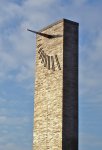 |
Columbus |
Indiana |
USA |
Vertical Dial |
Dial 675 |
| An approximately 10 x12 foot brick and stainless steel south-facing dial atop a 50 foot tower. This resembles an actual vertical dial but has a horizontal gnomon rather than a polar-pointing gnomon. The hour lines verify against ZW2000 software calculated angles for a due south dial but are non-functional with a horizontal gnomon. Dial face includes hour lines for 6 AM to 2 PM but no numerals. It's more sculpture than sundial. |
| |
| |
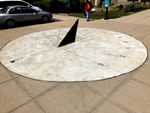 |
Fort Wayne |
Indiana |
USA |
Horizontal Dial |
Dial 988 |
| This is a large 20 foot diameter horizontal dial embedded in the cement sidewalk. Brass hour lines extend from the edge of the circular dial to the toe of the gnomon. The gnomon itself is a brass triangle, tarnished except for its tip that is frequently rubbed by visitors. Arabic numerals mark time by hours from 6 am to 6 pm. |
| |
| |
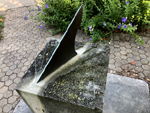 |
Fort Wayne |
Indiana |
USA |
Horizontal Dial |
Dial 987 |
| This horizontal dial is 16 inches square, made of limestone with a brass gnomon. The gnomon angle is 30 deg, certainly not correct for the dial's latitude of 41 deg. Nonetheless, it appears that the dial was made for its site as the gnomon and dial numbers are rotated on the square to point due north. Arabic numerals mark time by hours from 8 am to 6 pm, with raised hour lines extending toward the gnomon. The equation of time is shown as a graph on one side of the plinth. The limestone is deteriorating with age and is now covered with lichen. The 3 and 4 pm numbers are nearly obliterated and in several more years many of the other hour numbers will vanish. The dial is situated under trees with little opportunity to see the sun. |
| |
| |
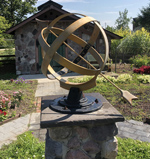 |
Fort Wayne |
Indiana |
USA |
Armillary Sphere |
Dial 986 |
| This is a 32 inch diameter armillary dial made of painted steel. The gnomon is a classic arrow at a 41 deg angle. The equatorial band is painted black with bronze colored Roman numerals indicate the hours from 6 AM to 6 PM. The dial is mounted on a field stone plinth. |
| |
| |
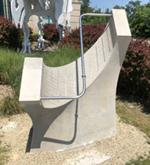 |
Fort Wayne |
Indiana |
USA |
Equatorial Dial |
Dial 956 |
| According to WPTA-21 news, "This odd looking nine thousand pound chunk of limestone is a scientific instrument, a sundial unlike any you’ve seen." It is an equatorial dial but with a parabolic shaped equatorial for telling time. The reason for the odd shape? "The shadow cast by a stainless steel bar moves across the dial face telling time not just in Fort Wayne but also half a world away in Takaoka, Japan, one of Fort Wayne’s Sister Cities. A half-size version of the same sundial in Takaoka does the same thing." |
| |
| |
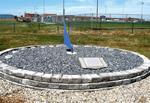 |
Fort Wayne |
Indiana |
USA |
Horizontal Dial |
Dial 677 |
| A 15 foot diameter stone and cement horizontal dial with a painted steel gnomon. 6 AM to 6 PM hour markers have Arabic numerals. Interior area of dial is filled with crushed rock. A plaque provides EOT and longitude corrections and instructions. This dial was an Eagle Scout project built for this elementary school for use in science lesson plans. Dial sits within a two-course stone perimeter pedestal. |
| |
| |
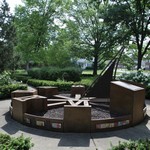 |
Indianapolis |
Indiana |
USA |
Horizontal Dial |
Dial 1006 |
| Nestled among the trees in a small triangular park is a monumental horizontal sundial with oversized hour marks. The apparent method of reading the Roman hours that are all south of the 6am - 6pm line, is to look at the shadow then gaze across the sundial to read (upside down) the hour. The hours are 6, 9 ,12, 3, and 6. On the north side of the 6am-6pm line are 3 plaques where the normal 9, 12, and 3 hours should be. One is a plaque for Robert McCord who planted and maintained the park during the 60's until his death. Another plaque records that the McCord Park sundial is dedicated to a local police officer, William Whitfield, who was the first African American police officer killed in the line of duty in Indianapolis. His name is engraved on the central part of the large triangular sundial gnomon. Surrounding the base of the sundial are ceramic tiles from Barbara Zech, a local clay artist who fired the tiles created by students from the nearby school. The tiles have the theme of "home" and "community". The park renovations were headed by the group Keep Indianapolis Beautiful. |
| |
| |
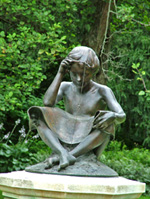 |
Indianapolis |
Indiana |
USA |
Sculpture/Artwork |
Dial 305 |
| Bronze Sundial, Boy with Spider
Gnomon wire is broken but present as of 2/2014. |
| |
| |
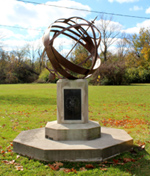 |
Indianapolis |
Indiana |
USA |
Armillary Sphere |
Dial 957 |
| This armillary is constructed adjacent to the original American Legion Wayne Post 64 building. It is made of iron with iron hour markers in Roman numerals on the equatorial band. It has arctic and antarctic circles and a longitude band from 6am to 6pm. The 45-inch diameter sphere sits atop a plain but elegant white square pedestal and octagonal dais. On the side of the pedestal are black marble plaques etched with the symbols of the Army, Navy, and Air Force. On the fourth side is the seal of the United States. |
| |
| |
 |
Indianapolis |
Indiana |
USA |
Sculpture/Artwork |
Dial 276 |
| A stainless steel and concrete vertical structure 33 feet tall called the "Totem". It has triangular and trapezoidal cut-outs, placed in the center of a concrete circle, with a sundial face but is not a functional sundial. |
| |
| |
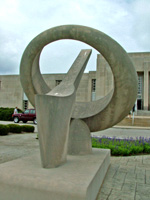 |
Indianapolis |
Indiana |
USA |
Equatorial Dial |
Dial 220 |
| A five foot diameter donut-shaped full circle equatorial pierced by equally massive Indiana Limestone shaft as gnomon. Hour numerals are Arabic. Subdivided into 15 minute increments. Equation of Time is given in the plaque at base |
| |
| |
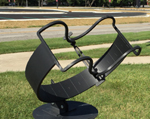 |
Kokomo |
Indiana |
USA |
Equatorial Dial |
Dial 826 |
| This is a hammered wrought iron equatorial sundial approximately 30 inches in diameter with a 6 inch equatorial band. The gnomon is a thin rod bracketed by an iron slit that is manually rotated to allow a bright beam of light to surround the shadow time-telling mark. The dial is designed to show local solar time, and requires the Equation of Time to correct for the tilted earth’s rotation axis and its eccentric orbit around the sun. |
| |
| |
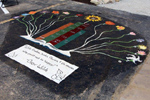 |
Kokomo |
Indiana |
USA |
Analemmatic Dial |
Dial 867 |
| This brightly decorated analemmatic sundial is painted on the asphalt to look like a book turning into flowers, showing the combination of literacy and nature. The dial is approximately 10 foot wide with hour marks from 5am to 7pm with drawings of various flowers. Noon is marked with a large sunflower. The central walkway is simply done with the abbreviated names of the months, one column in green, the other in red. |
| |
| |
 |
Lafayette |
Indiana |
USA |
Equatorial Dial |
Dial 376 |
| An 8 foot high equatorial dial of welded stainless steel with a brass gnomon and brass equatorial ring. The 60 inch diameter equatorial ring is engraved with hour marks and Roman numerals. Dial was commissioned by the cities of Lafayette and West Lafayette in celebration of the Millennium. Dial sits atop a short concrete pedestal. |
| |
| |
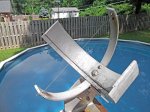 |
Muncie |
Indiana |
USA |
Equatorial Dial |
Dial 782 |
| A 9.5 inch wide bowstring equatorial dial built using the aluminum photo drum of a xerographic copier machine. The gnomon is stretched fishing line. Hour lines and numerals are marked by lead pencil and include 5-minute marks. The hour ring can be rotated to set for standard or daylight saving time and the elevation angle is adjustable. The dial is mounted on the deck railing of a swimming pool. |
| |
| |
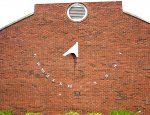 |
New Albany |
Indiana |
USA |
Vertical Dial |
Dial 704 |
| A 15 foot wide vertical dial declining 35 deg east of south on the brick face of a commercial building. Dial face has Roman numerals without hour lines. |
| |
| |
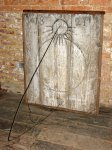 |
New Harmony |
Indiana |
USA |
Vertical Dial |
Dial 620 |
| A historic wood and iron vertical dial 34 inches wide x 42 inches high x 1-3/4 inches thick. This original Harmonist dial was made in 1821 by the Harmonie Society, a group of Lutheran separatists from Germany who settled in the US in the early 1800's. The original dial hung on a private house; when fire destroyed the house in 1844, the dial was rescued and placed on the south wall of Community House 2, located across the street from the destroyed house. A modern replica (similar at least) now is placed on the exterior wall and the original historic dial is on display inside and can be seen on a daily tour. |
| |
| |
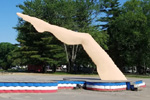 |
Roselawn |
Indiana |
USA |
Horizontal Dial |
Dial 971 |
| This dial consists of a fiberglass 18-foot high 36-foot gnomon in the shape of a bare tan-colored human leg. Hence the dial's name of "The Leg". The tip of the toe acts as a nodus. There are no hour lines and no declination lines. Instead, during summer months a series of hour markers are arranged on ground beneath the path of the nodus shadow. |
| |
| |
 |
South Bend |
Indiana |
USA |
Compound Dial |
Dial 710 |
| A combination horizontal dial with nodus on its gnomon and a meridian projection dial located below. Horizontal dial face is 44 inches diameter and made of polished Chinese gabbro basaltic rock, reflecting clouds overhead and gnomon shadow, which shows location of solar noon on gnomonic projection map of the world on dial face. Gnomon is supported by curved triangular bronze arches. Gnomon nodus shadow shows location on map where sun is directly overhead while solstice and equinox lines indicate date. Hour markers show EDST by Roman numerals with ten minute increments by Arabic numerals and marks for one minute. Dial is supported on an octagonal limestone pedestal with French Gothic cathedral window design allowing viewing of meridian dial date line.
Meridian dial is placed below the octagonal limestone pedestal whose French Gothic cathedral window design allows the noon date line to be seen. The date line is illuminated only at noon by sunlight passing through a slit orifice that extends 2/3 the way up the pedestal wall, indicating dates between summer and winter solstice by the end of the end of the bar of light.
The entire combination dial sits on a plaza inlaid with three types of granite to form a 32 foot diameter compass rose, with sunrise and sunset times shown for sixteen dates special to Notre Dame University. |
| |
| |
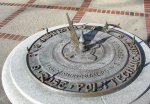 |
Terre Haute |
Indiana |
USA |
Horizontal Dial |
Dial 685 |
| A round bronze horizontal dial with 6 AM to 6 PM hour lines and half-hour lines and Arabic hour numerals. Eight perimeter points and the one central decorative point may represent alignments but no explanation is given. Dial sits on a carved stone column. Base marked 1920 1921 1922 1923. |
| |
| |
 |
Terre Haute |
Indiana |
USA |
Sun Alignment |
Dial 586 |
| Via Solaris, a 20x15x4 foot granite, stainless steel and bronze calendrical dial showing yearly equinoxes and summer solstice. |
| |
| |
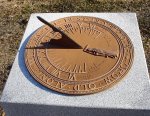 |
Vincennes |
Indiana |
USA |
Horizontal Dial |
Dial 687 |
| a 14 inch diameter cast metal horizontal dial with 15 minute hour lines and Roman hour numerals. Sunrise and sunset times at solstices marked by additional lines. Dial face includes grim reaper figure. Hour lines and gnomon may be designed for different latitude; this may be a commercial dial but it is clever and unrecognized if so. Dial sits on a square tapered marble pedestal with stepped square bases. |
| |
| |
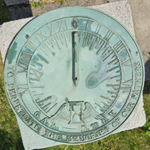 |
Wabash |
Indiana |
USA |
Horizontal Dial |
Dial 1125 |
| This horizontal bronze dial is approximately 12 inches (30cm) in diameter with a heavy green patina. The gnomon long ago was broken off. The inner chapter ring shows local solar time in half hour increments marked in Roman numerals from 6am to 6pm. The dial is decorated by an hour glass. The dial sets on a square 12x12 in (30x30cm) plinth. The pedestal is a column 4 in (10cm) in diameter and approximately 36in (91cm) tall with the top half fluted. |
| |
| |
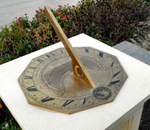 |
Westville |
Indiana |
USA |
Horizontal Dial |
Dial 1008 |
| This marine brass sundial at first glance is just a beautiful horizontal sundial with Roman hour marks delineated at 1 minute intervals from 5am to 7pm . But look carefully and at the base of the gnomon on the north side is a vertical stile whose shadow graces a stereographic projection of a grid of 5-minute solar time lines vs solar declination at degree intervals spanning +/- 23.5 deg where the summer and winter solstice paths are highlighted by a bead of small solar dots. |
| |